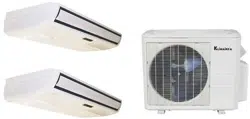Loading ...
Loading ...
Loading ...

12
installation manual
•Refrigerant containers must be opened slowly.
Always use protective gear when charging the system.
•DO NOT mix refrigerants types.
The outdoor unit is factory charged with refrigerant. Calculate
the added refrigerant according to the diameter and the
length of the liquid side pipe of the outdoor unit/indoor unit
connection.(suitable for throttle outdoor unit)
Table 9-1
Liquid tube(mm) R410A R22
Ø6.35
Ø9.52
Ø12.7
Ø15.9
Ø19
0.022kg/m×(L-5)
0.011kg/m×(L-5)
0.060kg/m×(L-5)
0.030kg/m×(L-5)
0.110kg/m×(L-5)
0.060kg/m×(L-5)
0.170kg/m×(L-5)
0.085kg/m×(L-5)
0.250kg/m×(L-5)
0.125kg/m×(L-5)
0.030kg/m×(L-5)
0.015kg/m×L
0.065kg/m×(L-5)
0.030kg/m×L
0.115kg/m×(L-5)
0.060kg/m×L
0.190kg/m×(L-5)
0.095kg/m×L
0.290kg/m×(L-5)
0.145kg/m×L
orifice in the indoorunit
orifice in the outdoorunit
orifice in the outdoorunit
orifice in the outdoorunit
orifice in the outdoorunit
orifice in the outdoorunit
orifice in the indoorunit
orifice in the indoorunit
orifice in the indoorunit
orifice in the indoorunit
9.
AIR EVAC
TION
Safety P recautions
CAUTION
•Use a vacuum pump with a gauge reading lower
than -0.1MPa and an air discharge capacity above
40L/min.
•The outdoor unit does not need vacuuming. DO
NOT open the outdoor unit ’s gas and liquid stop
valves.
•Ensure that the Compound Meter reads -0.1MPa
or below after 2 hours. If after th ree hours of
operation and the gauge reading is still above
-0.1MPa, check if the re is a gas leak or water inside
the pipe. If the re is no leakage, perform another
evacuation for 1 or 2 hours.
•DO NOT use refrigerant gas to evacuate the system.
Evacuation Instructions
Before using manifold gauge and vacuum pump, read their
operation manuals to familiarize yourself with how to use
them properly.
Manifold Gauge
Compound gauge
--76cmH
Low pressure valve
High pressure valve
Charge hose
Charge hose
Vacuum pump
Pressure gauge
Low pressure valve
Fig. 9.1
1. Connect the charge hose of the manifold gauge to
service port on the outdoor unit’s low pressure valve.
2. Connect another charge hose from the manifold gauge
to the vacuum pump.
3. Open the Low Pressure side of the manifold gauge.
Keep the High Pressure side closed.
4. Turn on the vacuum pump to evacuate the system.
5. Run the vacuum for at least 15 minutes, or until the
Compound Meter reads -76cmHG (-1x105Pa).
6. Close the Low Pressure side of the manifold gauge, and
turn o the vacuum pump.
7. Wait for 5 minutes, then check that there has been no
change in system pressure.
NOTE:
the table above refer to the liquid tube.
The number of bends is up to the length of the max height drop.
Usually for each 10m need a bend.
If a negative result is gotten for R from Table 9-1, no refrigerant
needs to be added nor removed.
Additional refrigerant will be twice of R from Table 9-1 if the indoor
unit installed throttle assembly.
NOTE: If the re is no change in system p ressure, unsc rew
the cap f rom the packed valve (high p ressure valve). If
there is a change in system p ressure, the re may be a gas
leak.
Note On Adding Refrigerant
8. Insert hexagonal wrench into the packed valve (high
pressure valve) and open the valve by turning the
wrench in a 1/4 counterclockwise turn. Listen for gas to
exit the system, then close the valve after 5 seconds.
Flare nut
Cap
V alve body
V alve stem
Fig. 9.2
9. Watch the P ressure Gauge for one minute to make su re
that there is no change in p ressure. The P ressure Gauge
should read slightly higher than atmospheric p ressure.
10. Remove the charge hose f rom the service port.
11. Using hexagonal w rench, fully open both the high
pressure and low p ressure valves.
OPEN VALVE STEMS GENT LY
When opening valve stems, tu rn the hexagonal w rench
until it hits against the stoppe r. DO NOT try to fo rce the
valve to open furthe r.
12. Tighten valve caps by hand, then tighten it using the
proper tool.
CAUTION
•Refrigerant charging must be performed after
wiring, vacuuming and the leak test.
•DO NOT exceed the maximum allowable quantity
•
of refrigerant or ove rcharge the system. Doing so
can damage or impact the unit ’s function.
Charging with unsuitable substances may cause
explosions or accidents. Ensure that the appropriate
refrigerant is used.
Loading ...
Loading ...
Loading ...
